Creme Anglaise (Vanilla Custard Sauce), or English Cream, is a versatile dessert that takes only 30 minutes to prepare. This timeless recipe is a must-try and makes the perfect addition to any dessert table.

WANT TO SAVE THIS RECIPE?
Creme Anglaise, which literally translates to 'English Cream,' was one of my favorite childhood desserts. Thinner than custard, this vanilla custard sauce has a pouring consistency as it contains no flour or cornstarch. The ingredients are simple, and with the help of the steps and tips outlined below, you'll master this recipe in no time.
I like to serve my creme anglaise with fruit and Jell-O for a simple dessert, add it to a homemade trifle, or serve it warm over apple crumble for an effortless holiday dessert. A few other easy desserts you will love are my custard sauce (orange creme anglaise), date dessert, lemon posset, lemon curd, and mango dessert.
Jump to:
Why you'll love this recipe
- Perfect for all seasons - Crème anglaise can be served chilled or warm, making it the perfect dessert sauce all year round.
- Great way to use egg yolks - Every time I make a meringue, macarons, or pavlova, and have tons of egg yolks left over, I use them to make this recipe.
- Numerous pairing options - There are many ways to use this vanilla custard sauce. I shared a few of my favorites earlier, but a few other uses are on a souffle, poured over a spiced cake, or drizzled on some poached seasonal fruit.
Ingredient notes

- Egg yolks - Make sure the eggs are fresh and the yolks are well separated. Even a small amount of white can ruin the texture of the creme anglaise.
- Vanilla bean - I always prefer to use a vanilla bean for maximum flavor. I slice it lengthwise and scrape the center to add the fresh pulp to my custard. In a pinch, you can use extract or vanilla bean paste.
- Milk - Full-fat whole milk is best for this recipe's ideal texture and taste.
- Heavy whipping cream - I like my creme anglaise to have a pouring consistency. I always use a 1:1 ratio of milk and heavy whipping cream.
Please see the recipe card at the bottom of this post for the complete list of ingredients, measurements, and recipe instructions.
Substitutions & variations
- Thicker sauce - If you prefer a thicker sauce, Add 1 tablespoon of cornstarch. Whisk it into the egg and sugar mixture before you add the hot milk and cream to the eggs.
- Swap out the vanilla - Try nutmeg, cinnamon, or even amaretto instead of the vanilla in this creme anglaise recipe.
- Add more flavor - Lemon or orange zest, infused sugar, and even shaved chocolate help elevate this dessert sauce.
Step-by-step instructions

First step - Add the milk, cream, vanilla, and all but 2 tablespoons of sugar to a double saucepan and heat.
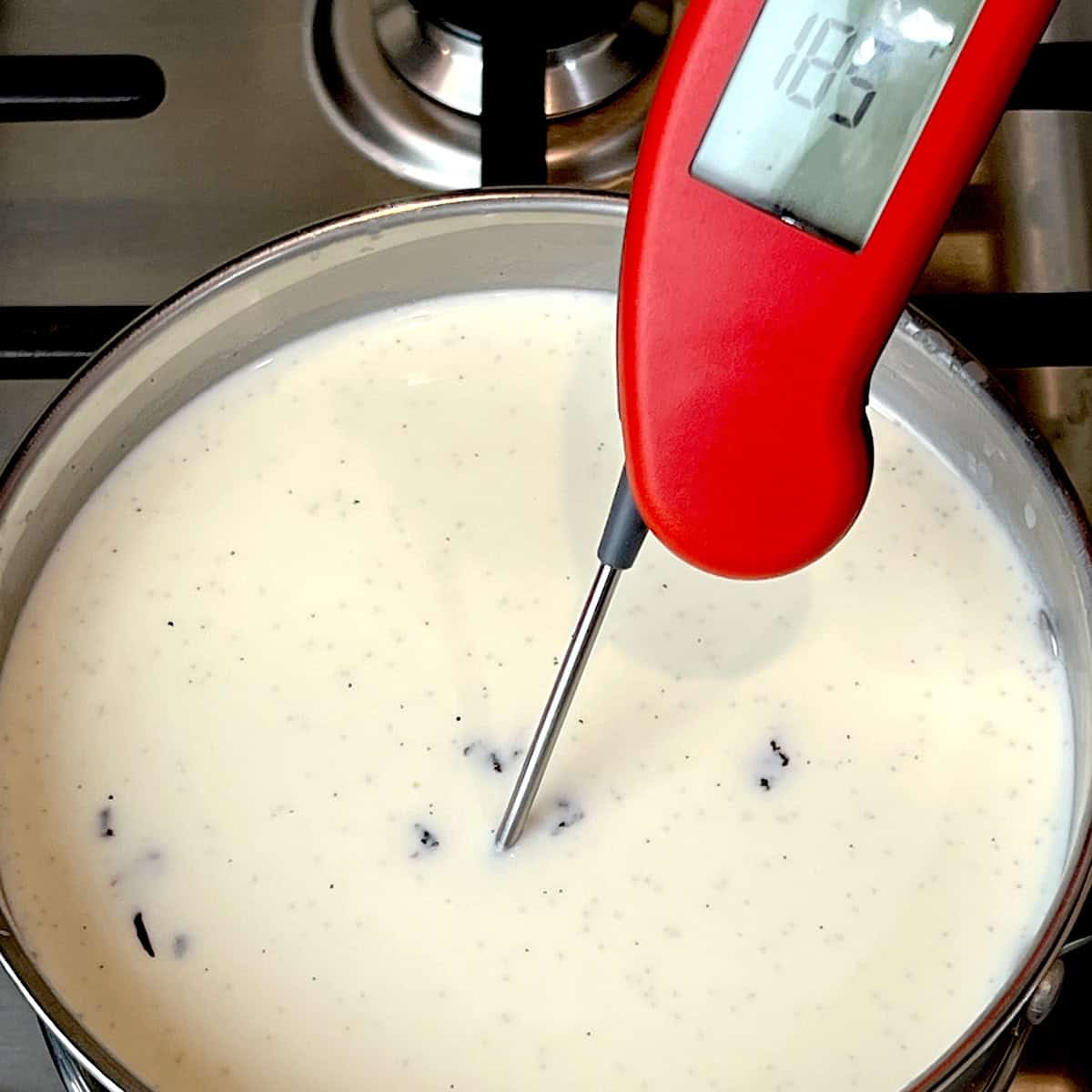
Second step - Check the mixture's temperature and heat to 180 degrees Fahrenheit for perfect results. If it gets too hot, remove it from the stove and let it cool down before adding it to the eggs.

Third step - Beat the egg yolks with the sugar as you wait for the milk and cream to heat up.

Fourth step - Leave the bottom part of the double saucepan on the stove so the water stays hot. Remove the top portion and pour a steady stream of the hot mixture into the beaten yolks, whisking constantly to prevent curdling.
Return the mixture to the double saucepan and continue to stir constantly until it coats the spoon. Pour the creme anglaise into a chilled bowl and place it in a larger container filled with ice. Stir at intervals till the custard is at room temperature, and then place in the fridge to chill. The custard will continue to thicken as it gets colder.
Expert Tips
- The ice bath is a must - Immediately cooling the custard helps ensure a smooth texture. Don't skip this step!
- Use the vanilla stick - Set your vanilla stick aside after you remove the pulp and add it back to the cooked custard, leaving it in the creme anglaise as it cools overnight. Remove it just before serving.
- Use a thermometer - Keeping the milk and cream mixture at the perfect temperature ensures the custard does not curdle. I highly recommend using a thermometer.
- Temper the eggs - Slowly add the hot liquid to the egg and sugar mixture off the stove. Stir constantly until you have a well-blended mixture, and then return to the heat. This method guarantees a silky-smooth vanilla custard sauce.
Recipe FAQS
For a slightly grainy texture, strain the creme anglaise through a fine mesh sieve to restore its texture. If you feel it's past the grainy stage, use an immersion blender or run the custard through a blender. If necessary, add a tablespoon or two of heavy whipping cream to help regain the desired velvety texture.
You've followed all the steps and chilled your custard, but it's too runny. Now what? Return the mixture to the stove in a double saucepan and heat to 165 degrees Fahrenheit. Beat 2 egg yolks with ½ a tablespoon of sugar and slowly pour 1 cup of hot custard into these eggs, whisking constantly. Add this back to the remaining custard in the double saucepan and stir constantly until the sauce thickens. Cool down and refrigerate as before.
The creme anglaise can be refrigerated for up to 5 days. For best results, I don't suggest freezing the vanilla custard sauce. I always try and make small batches, so I don't have too many leftovers.

Other dessert recipes you may like
If you decide to try this recipe, Please don't forget to leave a rating and comment below! If you take a picture, tag me on Instagram! Thank You!
Creme Anglaise (Vanilla Custard Sauce)
WANT TO SAVE THIS RECIPE?
Ingredients
- 1 cup heavy whipping cream
- 1 cup full fat milk
- 5 egg yolks
- ½ cup sugar
- 1½ teaspoon vanilla extract (see notes)
Instructions
- Measure and set all the ingredients on your counter. Timing is key so have everything at hand including all necessary utensils.
- Fill the bottom of your double saucepan with water and set it on the stove to boil. (see notes)
- Fill an empty bowl with ice and nestle another smaller empty bowl on top of it, ready to pour the custard into.
- Beat the egg yolks with 2 tbsps of sugar and set aside.
- Put the milk, cream, and remaining sugar in the top portion of the double saucepan and set to heat. Use a thermometer and heat the mixture to 180 degrees Fahrenheit. (see notes)
- When the liquid is hot enough, remove it from the stove and add it very slowly to the eggs, whisking vigorously to prevent the eggs from curdling. (see notes)
- Return the entire mixture to the top of the double saucepan. and whisk consistently till the custard starts to thicken.
- The custard is ready when it just coats the spoon and you can run a finger through the center, leaving a clean line there.
- Remove the custard and pour it into the chilled bowl placed on the ice. Stir gently for a little bit to help cool the custard, and leave it there till it reaches room temperature, stirring occasionally to prevent a film from forming.
- Refrigerate, chill overnight and then serve!



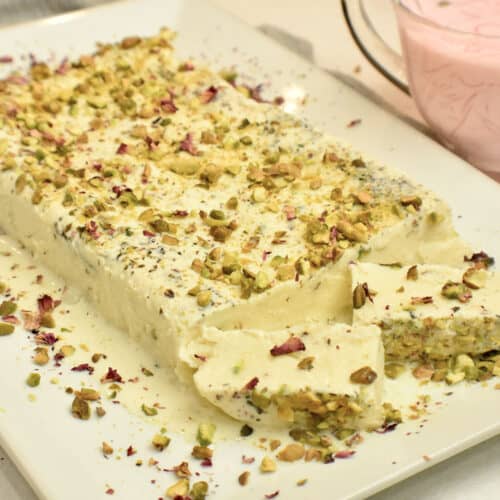
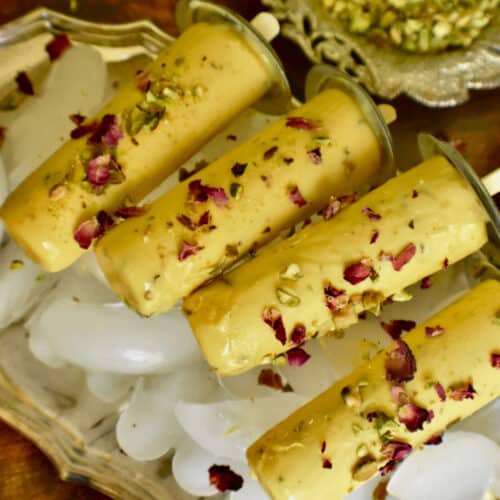



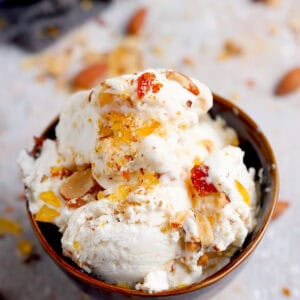
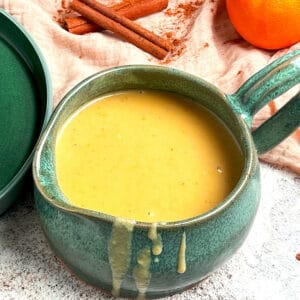
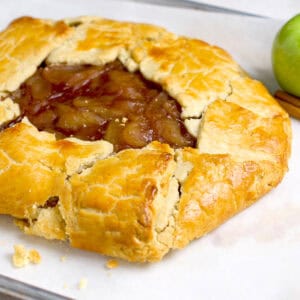
Leave a Reply